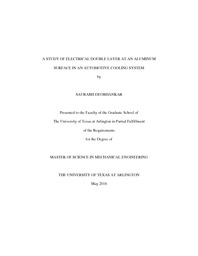
ATTENTION: The works hosted here are being migrated to a new repository that will consolidate resources, improve discoverability, and better show UTA's research impact on the global community. We will update authors as the migration progresses. Please see MavMatrix for more information.
Show simple item record
| dc.contributor.advisor | Yang, Bo | |
| dc.contributor.advisor | Nomura, Seiichi | |
| dc.creator | Deobhankar, Saurabh | |
| dc.date.accessioned | 2016-07-22T17:35:48Z | |
| dc.date.available | 2016-07-22T17:35:48Z | |
| dc.date.created | 2016-05 | |
| dc.date.issued | 2016-05-10 | |
| dc.date.submitted | May 2016 | |
| dc.identifier.uri | http://hdl.handle.net/10106/25823 | |
| dc.description.abstract | Electrolytic corrosion is identified as a major problem which adversely affects the performance of a cooling system and hence compromises the performance of automobile with it. Electrolysis corrosion is a chemical reaction process that occurs between a metal surface and electrolyte. Mostly, the radiator tubes and tanks are made of aluminum with a high heat transfer rate. The coolant flows under pressure through the aluminum tubes, which gives rise to erosion-corrosion. The present thesis sheds light on the corrosion mechanism of Al 3003 alloy radiator tubes in contact with 50/50 ethylene glycol water coolant. The main objective is to understand the formation of electrical double layer that is necessary in order to understand the charge transfer phenomenon when the metal electrode comes in contact with the electrolyte and corrodes. It includes a mathematical explanation for the governing equations of the dynamic transport of the electrolytic and corroding species.
In order to gain a perspective of the dominant ions responsible for corrosion, the double layer simulation is performed by considering the concentrations of water and ethylene glycol in the ratio 50:50 by weight %. Parametric study of changes in chemical composition is carried out by taking flux of Al ions, voltage and temperature as the parameters. The simulation results show that at low voltages (0.1V-0.5V), Cl- ions are dominant corroding species at the metal surface. In contrast, as the voltage increases gradually, Cl- ions concentration decreases. Meanwhile, the OH- ion concentration increases, which becomes eventually the dominant counter ion species at the metal surface. This observation implies that at low voltage the dominant Cl- ions are responsible for the pitting in aluminum surface. The resultant OH- ions help in formation of aluminum hydroxide which precipitates at the borders of the pit. At low temperature of 333 K and voltage of 0.8 V, it is observed that OH- ion concentration is more than that at 373 K and 0.8 V. It suggests a higher corrosion rate at higher temperature. | |
| dc.format.mimetype | application/pdf | |
| dc.language.iso | en_US | |
| dc.subject | Cl- | |
| dc.subject | OH- | |
| dc.title | A STUDY OF ELECTRICAL DOUBLE LAYER AT AN ALUMINUM SURFACE IN AN AUTOMOTIVE COOLING SYSTEM | |
| dc.type | Thesis | |
| dc.degree.department | Mechanical and Aerospace Engineering | |
| dc.degree.name | Master of Science in Mechanical Engineering | |
| dc.date.updated | 2016-07-22T17:37:55Z | |
| thesis.degree.department | Mechanical and Aerospace Engineering | |
| thesis.degree.grantor | The University of Texas at Arlington | |
| thesis.degree.level | Masters | |
| thesis.degree.name | Master of Science in Mechanical Engineering | |
| dc.type.material | text | |
| dc.creator.orcid | 0000-0002-7291-4288 | |
Files in this item
- Name:
- DEOBHANKAR-THESIS-2016.pdf
- Size:
- 1.780Mb
- Format:
- PDF
This item appears in the following Collection(s)
Show simple item record


